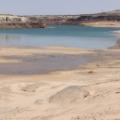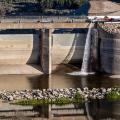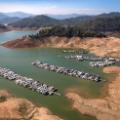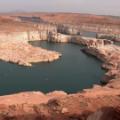
(CNN) In the Colorado River Basin, where the nation's largest bodies of water are sinking at an alarming rate, California's two largest reservoirs, Lake Shasta and Lake Aroville, are facing similar battles.
Lighter year-round precipitation and snowfall, as well as more intense heat waves, directly contributed to the state's perennial, continuous drought, rapidly drying up reservoirs across the country. And according to this week's US Drought Monitoring Report, the two major reservoirs are at "critically low" times of the year when they should be at their peak.

This week, Lake Shasta accounts for only 40% of its total capacity , the lowest since early May 1977. Further south, Lake Auroville occupies 55% of its capacity , with an average of 70% where it should be at the moment.
Lake Chasta is the state's largest body of water , the cornerstone of the Central California Valley Project, a complex water system consisting of 19 dams and reservoirs, as well as more than 500 miles of canals stretching north-south from Reading. Drought in Bakersfield has hit the landscape.
The water level of Lake Shasta is now less than half of the historical average. According to the US Rescue Bureau, this year the Central Valley program will provide water only to agricultural consumers who have long had the right to water - some irrigation plots in the Arjelyan San Joaquin Valley.
"We anticipate that more than 350,000 acres of land will explode in the Sacramento Valley alone," Mary Lee Kenchett, public relations officer for the California Bureau of Greater Basin, told CNN. As for this, this is a big area away from Los Angeles. "Cities and villages receiving water [Central Valley Project], including the Silicon Valley community, have been reduced to health and safety needs only."
Jessica Gable of Food and Water Watch , a non-profit organization focused on food security, water and climate change, says many of them are at risk of supply shortages. He said the coming summer heat and water shortages would hit California's most vulnerable groups, especially in rural communities.
"All the communities in California will be affected by this year's drought, the question is how much more," Goebbels told CNN. "Usually the most vulnerable communities will suffer the most, so the central valley is usually remembered as the already dried-up part of the state, where most of the state's agriculture, most of its energy development comes from state property, water. intensive industries. "
"Only 5%" of water will be supplied.
The largest body of water in California's water system is Lake Aroville, which is disconnected from the Central Valley Project, which is managed by the California Department of Water Resources (DWR). It supplies water to California's 27 million acres of և 750,000 acres of farmland.
Aravil was hit hard last year as water levels plunged to 24% of total capacity, forcing it to shut down California's major hydroelectric plant for the first time since its opening in 1967 . The water level in the lake was under the slopes of the boats և open water intake pipes, which usually direct the water to supply the dam.

Although severe storms in late 2021 reduced the lake to record lows, power plants have resumed operations, and water officials have warned of another catastrophic situation as the summer drought worsens.
"The facility closed last August, it never did, and the likelihood of it happening again is very real," California Ginnews told a news conference in April as he visited the Auroville Dam, apparently creating a climate. . The crisis is changing the way water is supplied throughout the region.
According to the DWR, the low level of the Aroville Reservoir puts pressure on water companies, which "hope that government projects will receive only 5% of their reserves by 2022," DWR spokesman Ryan Andyan told CNN. "These water utilities are offered to adopt mandatory water use restrictions in order to increase their supply in summer and autumn.
For the third year in a row, the DWR, in conjunction with federal agencies, is taking unprecedented measures to protect winter-threatening salmon. Rehabilitation workers are now providing temporary cooling to cool the water in one of their fish farms.

Both reservoirs are an important part of the state's largest water system, connected by canals and rivers. Thus, even if the smallest bodies of water are filled with winter precipitation, the water level in Shasta և Aurovil decreases, which can still affect the rest of the water system, leading to its drying up.
For example, the water level in Lake Falsam this week reached about 450 feet above sea level, which is 108% of the historical average of this time of year. However, due to low water levels in Shasta և Oroville, the annual outflow from Lake Falsam this summer may be greater than usual to cover the significant shortfall in other bodies of water.
The California Sierra relies on winter storms to cover the snow in Njada, which then slowly melts in the spring and fills the water bodies.
Faced with record-breaking dry heat waves that swept across historic lands , California enjoyed the rain it was looking for in October when the first major storm of the season hit the coast. Then, in late December, more than 17 feet of snow fell in the Sierra Nևada , which, according to researchers, was enough to break decades of records.

But in January the amount of precipitation decreased, and the amount of state snow this year was only 4% of the norm at the end of winter.
Moreover, in Southern California, water district officials announced unprecedented water restrictions last week, urging businesses in Los Angeles, Ventura and some parts of San Bernardino to stop watering for one day every week from June 1.
Goebbels said that if California enters a much warmer, drier future than ever, officials and residents need to reconsider how it manages the water around it, otherwise the state will be unprepared.
"Water is a human right," Gable said. "But we do not think about it. I think until that is changed, unfortunately, water scarcity will continue to be a symptom of a worsening climate crisis."
0 Post a Comment
Post a Comment